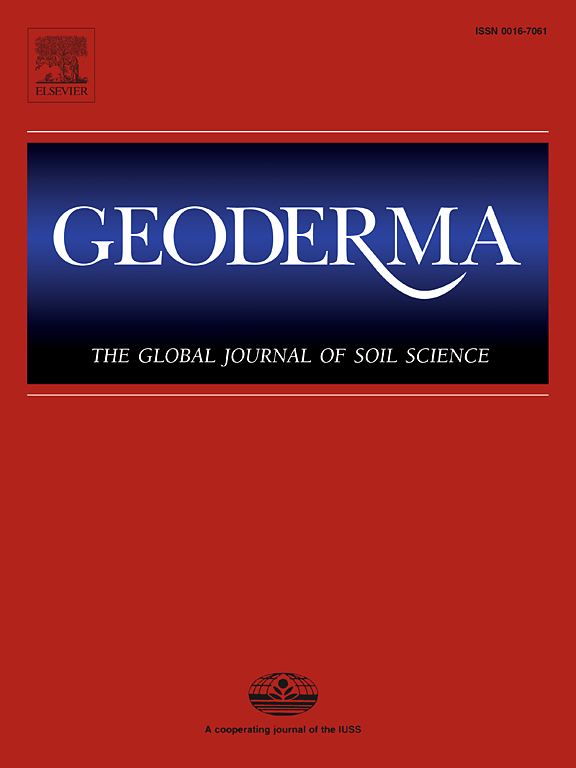Determination of future gully erosion risk and its spatially quantitative interpretability of driving factors in regional scale using machine learning algorithms
IF 5.6
1区 农林科学
Q1 SOIL SCIENCE
引用次数: 0
Abstract
Gully erosion has already caused severe damage to land production and ecosystem safety. It is pivotal to identify areas sensitive to and at risk from gully erosion for guiding gully erosion prevention and control efforts. Existing studies typically use gully erosion susceptibility modeling (GESM) to assess the severity of gully erosion at the watershed scale, focusing primarily on whether a gully forms, but not accounting for the risk of further gully development. This study proposed a new gully erosion risk modeling (GERM) method by combining GESM reflecting gully erosion potential and gully density modeling (GDM) reflecting current gully erosion situation in the whole rolling hilly region of northeast China with an area of 177,584 km2. A stratified random sampling (SRS) method was used to investigate the current state of gully erosion in study area. Gullies were interpreted as line features based on Google Earth images with the resolution of 0.3–0.6 m and further confirmed by field investigation, so all gullies in study area is spatially accurate. The results showed that the mean gully length and gully density were 335.85 m and 250.35 m km−2, respectively. The GERM was realized by four machine learning algorithms including Random Forest (RF), XGBoost, K-Nearest Neighbor (KNN), and Multi-layer perceptron of artificial neural networks (ANN-MLP). The results showed that XGBoost demonstrated the best overall performance (AUC = 0.999). The global Moran’s I index indicated significant spatial clustering of gully erosion risk and no risk. Although gullies tended to be stable in 44 % of the study area, the high risky zones accounted for 12.9 % which located in the eastern, central-northern, northwestern, and southern of study area. Additionally, we found that climate was a key factor driving gully formation, both topography and climate jointly impacted the current state or degree of gully erosion development, and the risk for further gully development was influenced by a combination of topography, climate, and human activities. This study revealed the future risk of gully erosion under the existing topography, climate, and human activities conditions in the rolling hilly region of northeast China, and explored the optimal algorithm for GERM, which can serve as a reference for the investigation, simulation, and management of gully erosion.
利用机器学习算法确定未来沟蚀风险及其区域尺度驱动因素的空间定量可解释性
沟蚀已经对土地生产和生态系统安全造成了严重的破坏。确定沟蚀敏感区和风险区对指导沟蚀防治工作具有重要意义。现有研究通常使用沟壑侵蚀敏感性模型(GESM)来评估流域尺度上沟壑侵蚀的严重程度,主要关注沟壑是否形成,而没有考虑沟壑进一步发展的风险。本文以东北地区177,584 km2为研究对象,将反映沟壑区侵蚀潜力的GESM模型与反映沟壑区侵蚀现状的GDM模型相结合,提出了一种新的沟壑区侵蚀风险建模(GERM)方法。采用分层随机抽样(SRS)方法对研究区沟蚀现状进行了调查。基于分辨率为0.3 ~ 0.6 m的谷歌地球影像,将沟壑解译为线状特征,并通过野外调查进一步确认,研究区所有沟壑在空间上都是准确的。结果表明:平均沟长为335.85 m,平均沟密度为250.35 m km−2;通过随机森林(Random Forest, RF)、XGBoost、k -近邻(K-Nearest Neighbor, KNN)和人工神经网络多层感知器(Multi-layer perceptron of artificial neural networks, ANN-MLP)四种机器学习算法实现了GERM。结果表明,XGBoost的综合性能最佳(AUC = 0.999)。全球Moran’s I指数显示出沟壑侵蚀风险与无风险存在显著的空间集聚性。研究区有44%的沟壑区趋于稳定,其中东部、中北部、西北部和南部的沟壑区为高风险区,占12.9%。此外,我们发现,气候是一个开车冲沟形成的关键因素,地形和气候共同影响当前状态或冲沟侵蚀程度发展,和进一步沟发育的风险受到地形、气候和人类活动的。本研究揭示了东北起伏丘陵区在现有地形、气候和人类活动条件下沟壑侵蚀的未来风险,并探索了最优的GERM算法,可为沟壑侵蚀的调查、模拟和管理提供参考。
本文章由计算机程序翻译,如有差异,请以英文原文为准。
求助全文
约1分钟内获得全文
求助全文
来源期刊

Geoderma
农林科学-土壤科学
CiteScore
11.80
自引率
6.60%
发文量
597
审稿时长
58 days
期刊介绍:
Geoderma - the global journal of soil science - welcomes authors, readers and soil research from all parts of the world, encourages worldwide soil studies, and embraces all aspects of soil science and its associated pedagogy. The journal particularly welcomes interdisciplinary work focusing on dynamic soil processes and functions across space and time.
 求助内容:
求助内容: 应助结果提醒方式:
应助结果提醒方式:


